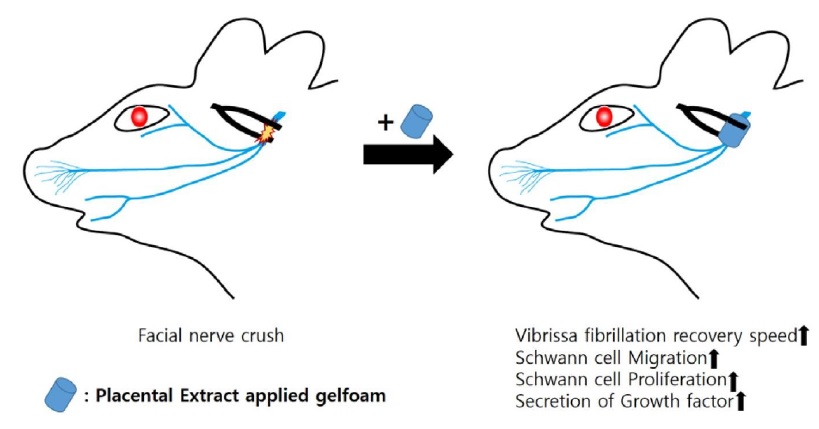Articles
Article Tools
Supplementary
Stats or Metrics
Article
Original Article
Exp Neurobiol 2022; 31(6): 419-430
Published online December 31, 2022
https://doi.org/10.5607/en22006
© The Korean Society for Brain and Neural Sciences
Enhancing the Effect of Placental Extract on the Regeneration of Crush Injured Facial Nerve
Gyeong Min Lim1†, Gwang-Won Cho1,2†, Chitra Devi Ganesan2, Ji Hyun Choi3, Mary Jasmin Ang4, Changjong Moon4* and Chul Ho Jang5*
1BK21 FOUR Education Research Group for Age-Associated Disorder Control Technology, Department of Integrative Biological Science, Chosun University, Gwangju 61452, 2Department of Biology, College of Natural Science, Chosun University, Gwangju 61452, 3Department of Obstetrics and Gynecology, Chosun University School of Medicine, Gwangju 61452, 4Department of Veterinary Anatomy, College of Veterinary Medicine and BK21 FOUR Program, Chonnam National University, Gwangju 61186, 5Department of Otolaryngology, Chonnam National University Medical School, Gwangju 61469, Korea
Correspondence to: *To whom correspondence should be addressed.
Changjong Moon, TEL: 82-62-530-2838
e-mail: moonc@chonnam.ac.kr
Chul Ho Jang, TEL: 82-62-220-6774
e-mail: jchsavio@gmail.com
†These authors contributed equally to this article.
This is an Open Access article distributed under the terms of the Creative Commons Attribution Non-Commercial License (http://creativecommons.org/licenses/by-nc/4.0) which permits unrestricted non-commercial use, distribution, and reproduction in any medium, provided the original work is properly cited.
Abstract
There is a scarcity of experimental studies on peripheral nerve regeneration using placental extract (PE). This study aimed to investigate the effects of topical PE application on recovery after crush injury to the rat facial nerve using functional, electrophysiological, and morphological evaluations. The viability of the RSC96 Schwann cells treated with PE (0.5~4 mg/ml) increased significantly. Immunoblot test revealed that PE application enhanced the migration of RSC96 cells. Quantitative polymerase chain reaction demonstrated that PE increased the expression of neurotropic genes. The recovery from vibrissa fibrillation in the PE-treated group was superior to that in the control group. The threshold of action potential was also significantly lower in the PE group. Histopathological examination showed that crushed facial nerves treated with PE exhibited larger axons. The surrounding myelin sheaths were more distinct and thicker in the PE-treated group. Hence, PE may be considered a topical therapeutic agent for treating traumatic facial nerve paralysis.
Graphical Abstract

Keywords: Placental extract, Facial nerve, Crush injury, Regeneration


